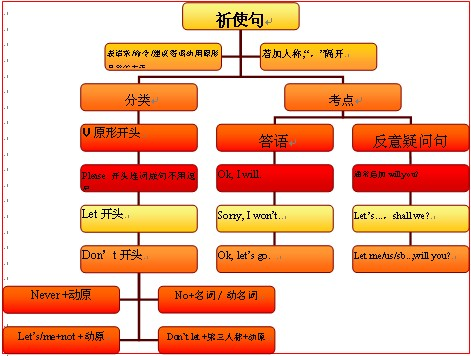本试题 “Bring the flowers into a warm room _____ they'll soon open.[ ]A. orB. andC. butD. for” 主要考查您对并列连词
祈使句
等考点的理解。关于这些考点您可以点击下面的选项卡查看详细档案。
- 并列连词
- 祈使句
并列连词的概念:
连词是一种虚词,它不能独立担任句子成分而只起连接词与词,短语与短语以及句与句的作用。连词主要可分为两类:并列连词和从属连词。并列连词用来连接平行的词、词组和分句。如:and, but, or, nor, so, therefore, yet, however, for, hence, as well as, both...and, notonly...butalso, either...or, neither...nor, (and)then 等等。
并列连词与并列结构:
并列连词引导两个并列的句子。
1)and与or:
判断改错:
(错) They sat down and talk about something.
(错) They started to dance and sang.
(错) I saw two men sitting behind and whisper there.
(对) They sat down and talked about something.
(对) They started to dance and sing.
(对) I saw two men sitting behind and whispering there.
解析:第一句:and连接两个并列的谓语,所以talk应改为talked。
第二句:and连接两个并列的动词不定式,第二个不定式往往省略to,因此sang应改为sing。
第三句:and连接感观动词saw后面的用作的宾补的两个并列分词结构,因此whisper应改为whispering。
注意:and还可以和祈使句或名词词组连用表示条件。(or也有此用法)
如:Make up your mind, and you'll get the chance.=If you make up your mind, you'll get the chance.
One more effort, and you'll succeed.=If you make one more effort, you'll succeed.
2)both...and 两者都
如:She plays(both) the piano and the guitar.
3)not only...but(also), as well as 不但…而且
如:She plays not only the piano, but(also) the guitar.
注意:not only…but also关联两个分句时,一个分句因有否定词not而必须倒装。
如:Not only does he like reading stories, but also he can even write some.
4)neither...nor 意思为“既不……也不……”谓语动词采用就近原则,与nor后的词保持一致。
如:Neither you nor he is to blame.
比较so和such :
so与such的用法由不同词性决定。such是形容词,修饰名词或名词词组,so是副词,只能修饰形容词或副词。so还可与表示数量的形容词many,few,much,little连用,形成固定搭配。
构成:so+adj.
such+a(n)+n.
so+adj.+a(n)+n.
such+n.(pl.)
so+adj.+n.(pl.)
such+n.(pl.)
so+adj.+n.[不可数]
such+n.[不可数]
如:so foolish
such a fool
so nice a flower
such a nice flower
so many/few flowers
such nice flowers
so much/ little money.
such rapid progress
so many people
such a lot of people
注:so many 已成固定搭配,a lot of 虽相当于many,但a lot of为名词性的,只能用such搭配。 so...that与such...that之间的转换既为so与such之间的转换。
并列连词用法点拨:
1、表示并列关系:
1)or意思为“否则”。
如:I must work hard, or I'll fail in the exam.
2)either...or意思为“或者……或者……”。注意谓语动词采用就近原则。
如:Either you or I am right.
2、表示转折或对比关系:
1)but表示转折,while表示对比。
如:Some people love cats, while others hate them.
典型例题:
—Would you like to come to dinner tonight?
—I'd like to, ___ I'm too busy.
A. and
B. so
C. as
D. but
答案:D。but与前面形成转折,符合语意。而表并列的and,结果的so,原因的as都不符合句意。
2)not...but...意思为“不是……而是……” not和but后面的用词要遵循一致原则。
如:They were not the bones of an animal, but(the bones) of a human being.
3、表示原因关系:
1)for 判断改错:
(错)For he is ill, he is absent today.
(对)He is absent today, for he is ill. for是并列连词,不能置于含两个并列分句的句子的句首,只能将其放在两个分句中间。
并列连词知识体系:
| 种类 | 用法 | 举例 |
| 并列连词 | 表示转折关系 | yet, but等 |
| 表示并列关系 | and, or, either...or..., as welll as等 | |
| 表示因果关系 | for, so等 |
比较and和or的用法:
1)并列结构中,or通常用于否定句,and用于肯定句。
2)但有时and也可用于否定句。请注意其不同特点:
如:There is no air or water in the moon.
There is no air and no water on the moon.
在否定中并列结构用or连接,但含有两个否定词的句子实际被看作是肯定结构,因此要用and。
典型例题:
—I don't like chicken___fish.
—I don't like chicken, ___I like fish very much.
A. and;and
B. and;but
C. or;but
D. or;and
答案:C。否定句中表并列用or,but表转折。
判断改错:
(错)We will die without air and water.
(错)We can't live without air or water.
(对)We will die without air or water.
(对)We can't live without air and water.
祈使句的概念:
表示请求或命令的句子是祈使句。祈使句一般用降调,为使祈使句听起来比较婉转,可用低声调,祈使句句末用句号或感叹号。祈使句有两种类型:含有第二人称和带有第一、三人称主语的祈使句。每种类型又有肯定形式和否定形式。用don't否定时,只能用其缩略形式。
例如:Welcome to Beijing Park.
祈使句的点拨:
一、祈使句的句式特征:
祈使句常常是表达说话人对对方的劝告、叮嘱、请求或命令等。因此,祈使句中一般没有主语,但根据其句意,实际上是省略了主语you。祈使句句末用感叹号或句号,朗读时,常用降调。在表达请求或劝告时,在祈使句前或句末可加上please,以使句子的语气更加缓和或客气。祈使句一般没有时态的变化,也不能与情态动词连用。
例如:Keep off the grass! 勿踩草地!
Put the boxes in the small room. 把那些盒子放到那个小房间里。
二、祈使句的肯定句式:
祈使句的肯定句式一般分为以下三种类型:
1、行为动词原形+其他成分:
例如:Make sentences after the model. 根据例句造句。
2、Be动词+其他成分(形容词、名词或介词短语等):
例如:Be careful when crossing the street. 过马路时要小心。
3、Let+宾语+动词原,形+其他,成分:
例如:Let him go back now. 让他现在回去吧。
三、祈使句的否定句式:
祈使句的否定句式,通常情况下在句首加上Don't或Never,一般分为以下四种类型:
1、在祈使句的肯定句式前加Don't,构成“Don't+行为动词原形+其他成分”。
例如: Don't say that again! 别再那样说了!
2、在Be动词引起的肯定祈使句前加Don't,构成“Don't be+其他成分(形容词、名词或介词短语等)”。
例如:Don't be careless. 不要粗心。
注意:在这种句型中be不能省略;否定副词not不可置于be之后。
3、Let引起的祈使句的否定形式有两种:
(1)Let开头的祈使句,如果后面跟第一、第三人称名词或代词的宾格,可在Let前加Don't,也可在Let后宾格的名词或代词后面加not。
(2)如果以Let's开头的祈使句,必须在Let's后加not。
例如:Don't let me go with her tomorrow.=Let me not go with her tomorrow. 不要让我明天跟她一起去。
Let's not tell her the truth whenever we meet her. 无论什么时候我们碰到她,都不要告诉她真相。
4、在公共场合的提示语中,否定祈使句常用“No+名词/V-ing形式”结构,表示“禁止做某事”。
例如:NOPHOTOS!禁止拍照!
四、祈使句的反意问句:
祈使句的反意疑问句须按其句子结构及讲话人的语气来决定其疑问部分。通常有以下三种形式:
1、祈使句为肯定句式,其反意疑问句表示请求时,通常用will you;表示邀请、劝说时,用won't you。
例如:Be sure to write to us, will you? 你一定要给我们写信,好吗?
Come to have dinner with us this evening, won't you? 今晚来和我们一起吃饭,好吗?
2、祈使句为否定句式,其反意疑问句通常只用will you。
例如:Don't smoke in the meeting room, will you? 不要在会议室抽烟,好吗?
3、Let开头的祈使句构成反意疑问句时,除Let's用shall we外,其他均用will you。
例如:Let the boy go first, will you? 让个那男孩先走,好吗?
Let's take a walk after supper, shall we? 晚饭后我们去散步,好吗?
五、祈使句的回答:
祈使句的动作通常是表示将来发生的动作,所以回答祈使句时,一般用will或won't。在回答具有否定意义的祈使句时,要注意两点:
一是“形式一致”,即Yes与will保持一致;No与won't保持一致。二是“意思相反”,即Yes是“不”的意思;No是“是”的意思。在回答时,要注意分析上下文语境中所提供的条件。
例如:—Don't go out, please. It's raining heavily outside. 请不要出去。外面雨下得很大。
—Yes, I will. I have to meet my brother at the airport. 不行,我得去机场接我弟弟。
祈使句知识体系:

祈使句的使用:
1、祈使句与陈述句的并列使用:
祈使句后接陈述句时,须用连接词连接。如果祈使句与陈述句表示的是一种顺承关系时,要用并列连词and来连接;
如果祈使句与陈述句存在一种否定条件关系时,要用并列连词or来连接。
例如:Leave it with me and I will see what I can do. 把它留给我吧,我想想有没有办法。
Hurry up, or we'll be late. 快点,否则我们要迟到了。
2、祈使句与条件状语从句的连用:
祈使句与条件状语从句连用时,条件状语从句可置于祈使句前或后。
例如:Tell him to make a phone call to me if he comes here tomorrow. 如果他明天来这儿的话,叫他给我来个电话。
3、祈使句的强调形式:
祈使句的强调形式通常在肯定祈使句式前加上助动词Do(Do在句中无意义)。
例如:Do shut up! 快住口!
4、特殊形式的祈使句:
在英语中,有些祈使句不是以动词原形来引起一个祈使句,而是以一个名词短语来充当,且后接一个带有并列连接词的分句。
实际上,这个充当祈使句的名词短语相当于一个条件状语从句。
例如:More water and the young trees couldn't have died.=If you had given them more water, the young trees couldn't have died. 如果你给那些小树多浇点水,他们就不会死了。
5、运用祈使句的误区:
祈使句往往容易与不定式、分词或条件状语从句相混淆。在平时的练习或测试中,如果稍不留神,就会出错。因此,要认真审题,认真分析句子结构,并根据上下文语境,作出正确判断。
例如:_____your composition carefully, some spelling mistakes can be avoided.
A. Having checked
B. Check
C. If you check
D. To check
析:如果空白处选填B(Check)项,则视为祈使句,但后一分句前没有并列连接词and连接;如选A或D项(分词或不定式),句中逻辑主语some spelling mistakes又不能执行这个动作,故均不符合句子结构。因此,只有C项(条件状语从句)符合句子结构及句意。
与“Bring the flowers into a warm room _____ they'll soon ope...”考查相似的试题有:
- Most disaster experts believe there is the potential ______ things could get a lot worse.A.whatB. whereC.whichD.that
- The spring outing really relaxed us a lot. That is its value lies.Awhat Bwhere Chow Dwhy
- —Haven’t seen Lucy recently,what’s happened?—Oh,it’s more than two months ________ she worked here.A.whichB.thatC...
- 短文改错。根据学生作业改编文中共有10处语言错误,错误涉及一个单词的增加、删除或修改。增加:在缺词处加一个漏词符号(/)...
- (2014届江西省重点中学盟校高三第二次联考英语试卷)31. Your IQ isn’t _____determines whether you will succeed in your ...
- 37.Today’s college is appropriate as a setting for a society,________ its members must acquire and manage knowledge ...
- ______ you think you can or not, you must finish the project before Friday.A.IfB.UnlessC.ThoughD.Whether
- The medicine works more effectively _______ you drink some hot water after taking it.A.asB.untilC.althoughD.if
- 34. -Are you sure you have to? It’s been very late.-I don’t know ________ I can do it if not now.A.howB.whatC.wh...
- The smoggy weather has made us realize terrible problems we are laced with.A.howB.whatC.thatD.which